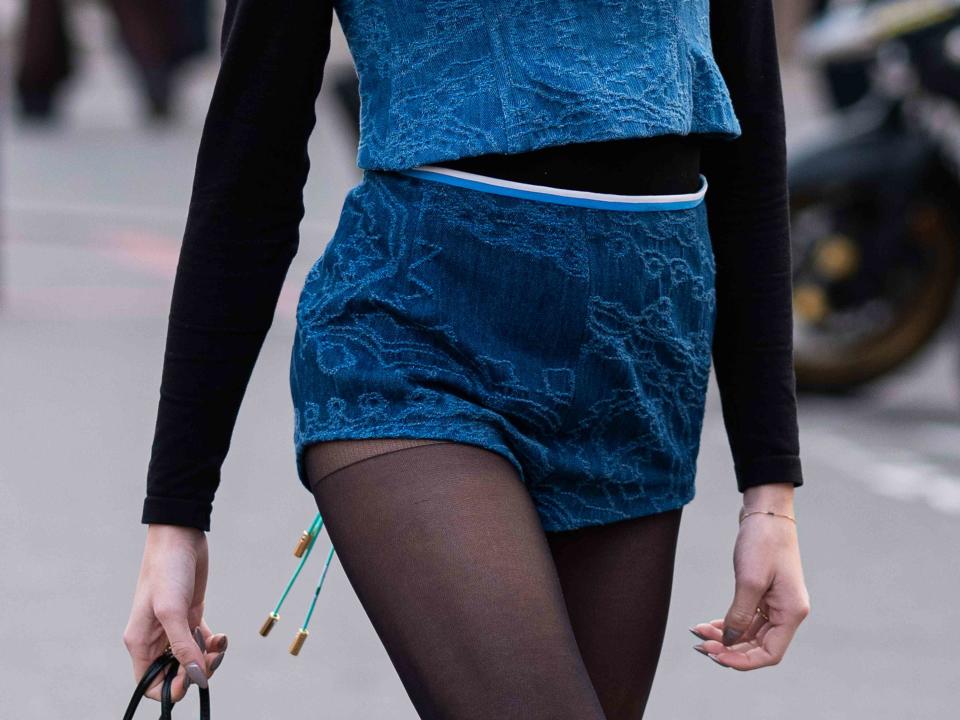Exactly What to Do If You're Dealing With Thigh Chafing
Wear short-shorts without suffering.

Getty Images
For anyone with thighs that touch (meaning most people on the planet), thigh chafing is often the bane of summer: You might want to wear a summer dress or shorts, but the pain of thigh chafing doesn't seem worth it. And, once you factor in sweaty thighs and summertime heat, it becomes a hard no.
But we have better things to do this summer than to be in pain because of thigh chafing — and so do you. Read ahead to learn from dermatologists about how to prevent thigh chafing, and the recommended methods and products they recommend to keep you comfortable all summer long.
Related:The Best Anti-Chafing Products For Thighs That Rub
What Is Thigh Chafing?
“Thigh chafing refers to the irritation that results from skin on the inner thighs rubbing against each other,” says Deanne Robinson, MD, a dermatologist in Westport, CT. “The irritation often presents as red, blister-like lesions that might burn, sting or in general feel uncomfortable.” It’s quite common and can happen year-round, but it’s usually especially frequent during summer, when the increased heat and moisture from your sweat can exacerbate the irritation.
That’s not to say that having thigh chafing implies that you’re overweight — since thigh chafing is just a by-product of the inner thighs experiencing friction. Your thighs could be chafed from wearing tight-fitting clothes that rub against your skin. Bottom line: Thigh chafing isn’t really indicative of how healthy or fit you are.
The Side Effects of Thigh Chafing
In theory, thigh chafing isn’t harmful, though it may feel uncomfortable. However, “while thigh chafing is not particularly harmful or concerning, it can worsen with continued friction,” says New York City dermatologist Marisa Garshick, MD. “Skin irritation can lead to discomfort, redness, pain, itching, infection, and scarring with discoloration.”
That being said, it can make day-to-day activities, like walking and jogging, very difficult due to the prolonged pain and discomfort, and can also cause the inner thighs to become especially sensitive to even the slightest pressure. If over-the-counter methods don’t provide any relief and chafing is left unchecked for a long period of time, the excessive friction on the thighs could cause the skin to be rubbed raw and could potentially cause the skin to open — and potentially bleed. In that case, our experts recommend seeing a board-certified dermatologist for help.
How to Treat Thigh Chafing
All of our experts recommend letting your skin rest by avoiding activities that could cause chafing. When bathing, make sure to use lukewarm water on your legs, avoid inflammation from hot water, and use a really gentle soap — that is, nothing heavily perfumed or stripping.
Afterwards, pat the skin dry with a clean towel, and apply your barrier-repair cream of choice before topping it off with a richer occlusive, such as Vaseline and Aquaphor, to seal the ingredients in. Joshua Zeichner, MD, dermatologist and professor at Mount Sinai in New York City, is also a fan of Lano Original 101 Ointment Multipurpose Superbalm.
Related:I Tried Anti-Chafe Thigh Bands, and Here's What I Thought
For regular maintenance, consider body creams and lotions with ceramides and hyaluronic acid, such as Avene’s Cicalfate+ Restorative Cream. If your thighs are really inflamed, Rachel Nazarian, MD, a dermatologist at Schweiger Dermatology, also recommends applying an over-the-counter 1% hydrocortisone cream to calm the skin down.
How to Prevent Thigh Chafing
Ultimately, “the best way to prevent chafing it’s to make sure that your skin barrier is kept in top shape,” says Dr. Zeichner. “Make sure to moisturize the skin regularly, and apply an occlusive product over high risk areas. Ceramides also help repair the skin barrier.” He also recommends wearing loose fitted clothes that won’t rub your skin when you’re out and about to prevent chafing caused by fabric. Breathable fabrics are preferred, while moisture-wicking fabrics are also a great option for sweatier situations.
There are plenty of products that promise to stop thigh chafing, but finding a method that works for you might take a little trial and error. Both Dr. Garshick and Dr. Robinson recommend Arm and Hammer Invisible Spray Powder to absorb moisture and help keep skin dry. Another great option: Megababe Thigh Rescue Stick, which gives thighs a little slip to prevent excessive friction.
A wearable option (and my personal favorite) are the Thigh Society Anti-Chafing Slip Shorts. An incredibly lightweight and breathable base layer, these shorts physically prevent the skin of your thighs from ever actually making contact. Ultimately, while finding the right thigh-chafing prevention is a matter of personal preference, it’s worth going the extra mile to stop it before it starts.
Related:How to Get Rid of Butt Acne for Good
For more InStyle news, make sure to sign up for our newsletter!
Read the original article on InStyle.

